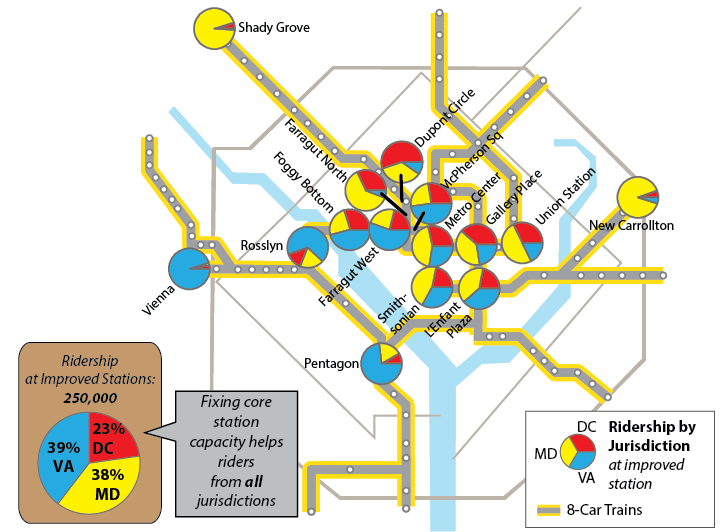Fixing Core Stations in Metro 2025 Helps Riders from All Jurisdictions
Though many of the stations that Metro 2025 seeks to improve are in the District of Columbia, the capacity expansion would help riders from all jurisdictions.
Metro needs to improve the capacity at over a dozen stations: some of these stations are at capacity today, and our 100% eight-car train program will bring even more customers to already crowded stations. We know we need to build new escalators, expand mezzanines, and build pedestrian passageways to meet this future demand.
The fact is that Metro 2025 is designed to benefit the Washington metropolitan area, residents of the District, Maryland and Virginia, as well as visitors from around the country and the world.
If you’re a commuter in Maryland or Virginia, it may look like the benefit of these improvements are focused on D.C. residents. After all, 10 out of the 15 stations are located in the District of Columbia. But the diagram below shows most of the riders who use these stations – those who create the need today, and who would benefit from fixing it – live in Maryland or Virginia. In fact, 77% of the users of the Metro 2025 stations live in the suburbs.
Help us make the Metro 2025 projects in Momentum a reality! Learn more about Momentum, call on your elected representatives, and endorse the plan.



A new blue line under M St. will help relieve congestion at most of these choke points. In SF, the BART system is exploring adding sidings to platforms at two of the busiest stations, Embarcadero and Montgomery, to help move people in and out. However, the BART system in SF needs an additional line in order to really alleviate congestion at these core stations by giving riders alternatives. Just look at NYC as another case in point: the west side boasts several N-S subway lines while the east side has only one which is the busiest in the system. It’s not rocket science that the 2nd Ave subway is necessary to help funnel people off the always packed Lexington Ave subway line, but nearly a century after it was first proposed the line has yet to be completed.
One of my friends said that since moving to Logan Circle two years ago she’s only taken Metro when going to the suburbs. I can see why. If you live in DC it makes more sense to walk, bike, Uber, or take the bus to other inner-city destinations. But in the suburbs the expensive and unreliable Metrorail is actually the most attractive option because the traffic and buses are so terrible.
@Caroline
You want expensive and unreliable transit? Come to San Francisco. Metro is far better than the systems we have here, many of which are not integrated. I live in the western part of SF and work downtown…approximately 6 miles door to door. Travel time on the light rail system is 40 minutes if things are running smoothly. Today, 1 hour 25 minutes.
Granted, Metro doesn’t go everywhere and nor should it. When I lived on 18th/Harvard I would walk to the Woodley Park station during commuting hours. Outside of that time I would walk.